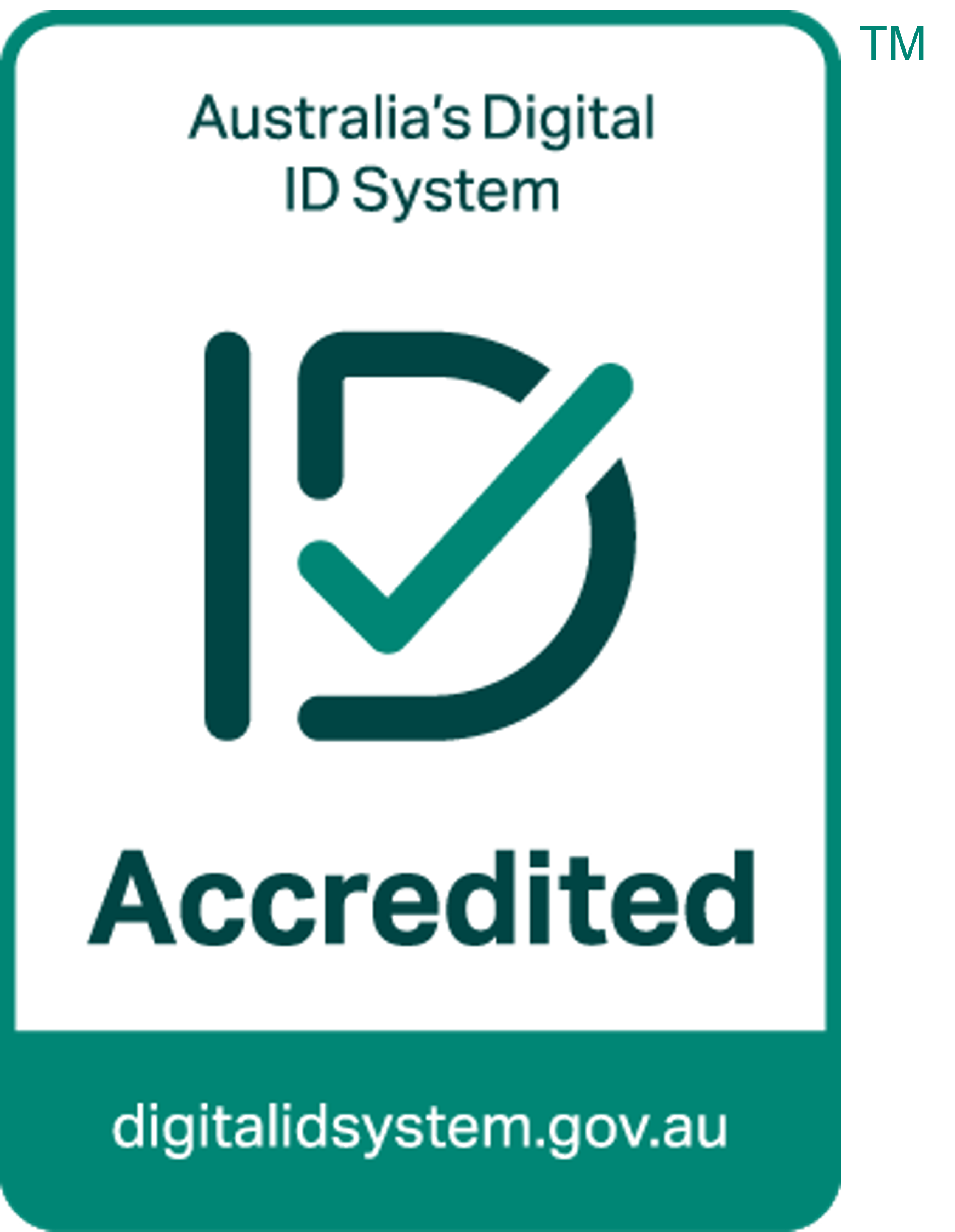On this page
Using a Digital ID
When accessing services, you often need to verify your ID. Different services have different ID requirements.
To set up a Digital ID, you will need to provide the details of your ID documents to a Digital ID provider. The details are then verified digitally with the agency who issued the document. Details can also be verified against characteristics of the document. This will verify that the document is real and owned by you.
For example: Driver license details are verified by the state or territory authority. Passport details are verified by the Department of Foreign Affairs and Trade.
Once your details are verified, the Digital ID is created. You can then use your Digital ID at any time to access connected services. With your consent, your Digital ID provider will only share information that the connected service requires.
When you create your Digital ID you'll be asked what strength you want. You can choose from Basic, Standard or Strong. The documents you need to create your Digital ID vary depending on what strength Digital ID you are trying to create and the app you use to create it.
Please read our Set up your Digital ID page.
Why biometrics?
Biometrics in online ID verification is becoming more important. This is because data breaches are becoming more frequent with more sophisticated fraud technology. Biometrics provide an additional level of security to your personal information.
For example: if a fraudster is trying to access your account, they wouldn’t be able to verify their face. As their face wouldn’t match your photo on your documents.
Setting up biometrics
To set up a Standard strength Digital ID with myID, you will need to verify at least two Australian ID documents. This can include your visa and ImmiCard, or your driver licence and your Medicare card.
To strengthen your myID to Strong with biometrics, you just take a selfie of your face which is then matched with the photo on your passport. This checks that you are a real person, and the right person. Soon after it is verified, the photo is deleted.
Proofing levels
Different services have different ID requirements, depending on the level of risk of incorrectly verifying you, or providing the service to the wrong person.
When you create your Digital ID you'll be asked what strength you want. You can choose from Basic (IP1, IP1+), Standard (IP2, IP2+) or Strong (IP3).
Services that have a higher level of risk, like applying for a tax file number online, will require a stronger Digital ID.
The more ID documents a service asks from you, the harder it is for someone to pretend to be you. This protects you and the service you’re accessing. For example, you don’t want it to be easy for someone to access your tax file number.
On this page
How Digital ID works

On this page
Australia's Digital ID System
Australia’s Digital ID System is made up of two parts:
- the voluntary Accreditation Scheme for digital ID service providers.
- the Australian Government Digital ID System.
Accreditation and the Australian Government Digital ID System have 3 core values:
- Privacy – protecting your personal information.
- Security – ensuring providers meet strict security standards.
- Integrity – overseen by the Digital ID Regulator and the privacy regulator.
The voluntary accreditation scheme
The Accreditation Scheme is voluntary. It is open to all government and private sector digital ID service providers across the economy.
Accreditation demonstrates that a provider meets strict rules and standards for:
- privacy protection
- security
- usability
- accessibility
- risk management
- fraud control and more.
These services are also subject to additional privacy safeguards. These are set out in law, with civil penalties for non-compliance.
Accreditation is only mandatory if a provider wants to join the Australian Government Digital ID System.
From 30 November 2024, the Digital ID Regulator is responsible for the Accreditation Scheme and accrediting digital ID providers. See information on becoming accredited.
You can also see a list of accredited entities on the Digital ID registers.
Accreditation Trustmark
Accredited providers will be able to display an Accreditation Trustmark from 1 December 2024. This shows they provide accurate, trustworthy digital ID services that protect people’s personal information and they’re regulated.

See more information on the Accreditation Trustmark.
The Australian Government Digital ID System (AGDIS)
The Australian Government Digital ID System provides a secure, convenient and voluntary way to verify who you are online.
The Australian Government Digital ID System is delivered and supported by six agencies. They are:
- Department of Finance
- The Office of the System Administrator
- Services Australia
- The Australia Competition and Consumer Commission
- The Office of the Australian Information Commissioner
- The Data Standards Body
- Australian Taxation Office
Some accredited providers are participating in the Australian Government Digital ID System. This means they can be used to access government online services.
The Australian Government Digital ID System includes the Relationship Authorisation Manager (RAM). This enables people to use their Digital ID to act on behalf of a business when accessing participating government services.
There are also many government services who use the system to verify their users. By December 2026 private businesses can apply to join the Australian Government Digital ID System.
See information about joining the Australian Government Digital ID System as a provider or a relying party.
On this page
The Office of the System Administrator
The System Administrator
- manages the day-to-day operation of the Australian Government Digital ID System.
- works with services to onboard them to the Australian Government Digital ID System. The Digital ID Regulator provides the approval to onboard.
Digital ID exchange
Services Australia operate the Digital ID exchange. The Digital ID exchange connects information between services and Digital ID providers within the Australian Government Digital ID System.
Digital ID providers
Digital ID providers help you set up and manage your Digital ID. myID (formerly known as myGovID) is the Australian Government's Digital ID provider.
More Digital ID providers will become available as the Australian Government Digital ID System expands.
To be part of the Australian Government Digital ID System, a provider must be accredited. An accredited provider must meet a range of high standards. These standards include privacy, cyber security and fraud control and more.
Digital ID providers within the Australian Government Digital ID System can’t track which services you access. This is a privacy and security protection built into the system. This protection ensures data is stored, transmitted and disposed of securely. You can be confident about how your information is held.
Attribute providers
Attribute providers verify specific attributes relating to entitlements or characteristics of an individual. For example, an attribute would be your authority to act on behalf of a business. The ATO’s Relationship Authorisation Manager (RAM) is an example of an attribute provider.
Regulating Australia’s Digital ID System
Australia’s Digital ID System operates under the Digital ID Act 2024 commencing on 1 December 2024.
The Digital ID Act is supported by legislative rules, made by the Minister for Finance, and data standards made by the Digital ID Data Standards Chair.
The Australian Competition and Consumer Commission (ACCC)
From 1 December 2024, the ACCC will be the Digital ID Regulator and they will be responsible for:
- ensuring each provider meets the requirements for accreditation.
- approving accredited providers to join the AGDIS.
- approving services seeking to use accredited providers in the AGDIS to verify their customers’ ID
- undertaking compliance and enforcement activities.
The Digital ID Regulator works with the System Administrator and the Office of the Australian Information Commissioner.
More information is available on the ACCC’s Digital ID website.
The Office of the Australian Information Commissioner (OAIC)
From 1 December 2024, the OAIC will be the privacy regulator of Digital ID and they will be responsible for:
- overseeing the privacy safeguards that apply to all accredited providers.
- handling complaints and conducting investigations of data breaches.
- assessing if accredited providers follow the privacy safeguards.
More information is available on the OAIC’s Digital ID website.
Digital ID Data Standards Chair
The Digital ID Data Standards Chair is responsible for developing and maintaining two sets of Digital ID Data Standards relating to:
- Identity Service Provider biometric testing and authentication requirements
- technical integration requirements for entities to participate in the AGDIS.
The Digital ID Data Standards Chair is supported by the Data Standards Body who will also support participants through the publication of user experience guidance and technical references.
